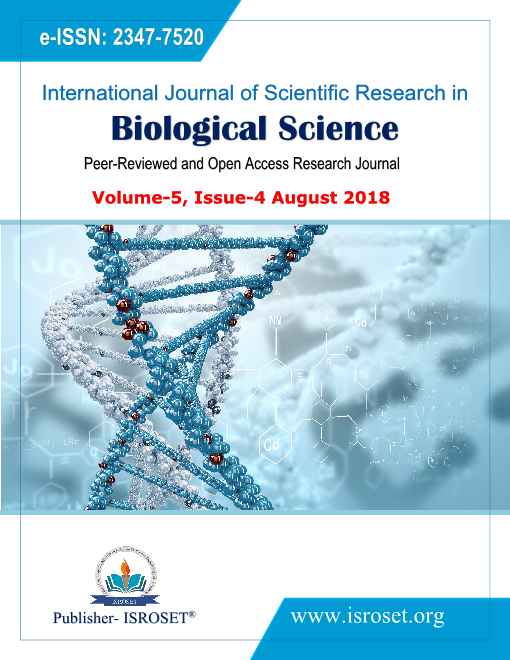Preliminary phytochemical screening and antifungal activity of bilimbi and papaya leaf extract on fungal pathogens
Keywords:
Aqueous leaf extract, Phytochemicals, Antifungal activity, Disc diffusion, Bilimbi, PapayaAbstract
The present study has witnessed the phytochemical and antifungal property of bilimbi and papaya aqueous leaf extracts. Through the preliminary phytochemical screening, bilimbi leaf extract indicated the presence of flavonoids, saponins, coumarins, steroids and papaya leaf extract indicated the presence of terpenoids, saponins, coumarins and steroids. We isolated and identified fungal pathogens from root and seed of paddy plant inoculated on PDA medium. Disc diffusion method was used to measure the antifungal property of leaf extracts on 3 selected fungal genera such as Cylindrocarpon, Penicillium and Curvularia which were used as test organism. The extracts having antimicrobial activity has varied diameter of zone of inhibition among the tested organisms. Bilimbi leaf extract has antifungal activity against Cylindrocarpon, Penicillium with zone of inhibition of 10mm, and 5mm respectively and no markable activity against Curvularia. Papaya leaf extract has antifungal activity against Cylindrocarpon, Penicillium and Curvularia with zone of inhibition of 12mm, 5mm and 15mm respectively. The highest level of antifungal activity was recorded in papaya leaf extract which was active against all tested organisms that may be due to the presence of different types of phytochemicals. Plant metabolites are strong candidate contribute to develop new leads, combat the emerging issues of drug resistance.
References
O. P. Sharma, "Fungi and allied microorganisms", McGraw Hill Education Pvt. Ltd, India pp. 280, 1989.
M. A. Chinju, M. T. Tincy, “Emerging fungal contaminants isolated and identified from raw fennel seeds”, International Journal of Scientific Research in Biological Sciences, Vol.5, Issue.3, pp.32-35, 2018.
J. Loeffler, D. Stevens, “Antifungal drug resistance”, Clinical Infectious Diseases, Vol.36, pp. 531-541, 2003.
A. D. Rocha, A. B. de Oliveira, J. D.de souza Filho, J. A. Lombardi, F.C. Braga, “Antifungal constituents of Clytostoma ramentaceum and Mansoa hirsute”, Phytotherapy Research, Vol.18, pp.463-467, 2004.
O. S. Koushik, P. S.Babu,, R. Karthikeyan, “Phytochemical screening and evaluation of antifungal activity on the seed extracts of Annona squamosa (L) and Manilkara zapota (L)”, CIB Tech Journal of Biotechnology,Vol. 6, Issue.1, pp. 8-11, 2017.
V.L. De Lima, E. D. Milo, L.D. Lima, “Physiochemical characteristics of bilimbi (Averrhoa bilimbi L.)”, Revista Brasileira de Psciquiatria Vol.23, pp.421-423, 2001.
Orwa, A.Mutua, R.Kindt, R.Jamnadass, S.Anthony, Agroforestree Database: a tree reference and selection guide, 2009.
T.K.Lim,“Edible Medicinal and non medicinal plants”, Springer, Netherlands, pp.867-878, 2012.
F.R. Ganders, “The biology of heterostyly”, New Zealand Journal of Botany, Vol. 17, pp. 607-635, 1979.
F.P Downes, K. Ito, “Compendium of Methods for the microbiological examination of foods”,APHA, Washington, D.C, 2001.
H. Mokhtar, A. Dehimat, “Contribution in isolation and identification of some pathogenic fungi from wheat seeds and evaluation of antagonistic capability of Trichoderma harzianum against those isolated fungi in vitro”, Agriculture and Biology Journal of North America, Vol.4, Issue.2, pp.145-154, 2013.
C. Booth, “Fusarium laboratory guide to the identification of the Major species”, Common wealth Mycological Institute, England, pp. 58, 1977.
S. Ronhede, B. Jenesen, S. Rosendahl, B. B. Kragelund, R. K. Juhler, J. Amand, “Hydroxylation of the herbicide isoproturon by fungi isolated from agricultural soil”, Applied and Environmental microbiology ,Vol.71, Issue.12, pp.7927-7932, 2005.
P. N. Rajankar , D. H. Tambekar , S.R. Wate , “Study of phosphate solubilization efficiencies of fungi and bacteria isolated from saline belt of purna river basin”, Research Journal of Agriculture and Biological Sciences, Vol.3 ,Issue. 6, pp.701-703, 2007.
P.K. Basu, “Production of Chlamydospore of Phytophthora megasperma and their possible role in primary infection and survival in soil”, Canadian Journal of Plant pathology, Vol. 2, pp. 70–75, 1980.
K. Vijay, S. Sriram , “In vitro antibacterial activity in seed extracts of Manilkara zapota, Annona squamosa and Tamarindus indica”. Biological Research, Vol. 43, pp.165–168, 2010.
F. Nasrin , I. J. Bulbul, Y. Begum, S. Khanum , “Invitro antimicrobial and cytotoxicity screening of n-hexane,chloroform and ethyl acetate extracts of Lablab purpureus (L.) leaves”. Agriculture and Biology Journal of North America, Vol. 3, Issue.2, pp. 43–48, 2012.
S. Balakumar, S. Rajan, T.Thirunalasundari, S. Jeeva,S, “ Antifungal Activity of Aegle Marmelos (L.) Correa (Rutaceae).Leaf extract on dermatophytes”. Asian Pacific Journal of Tropical Biomedicine, Vol. 1, issue.4, pp. 309 – 312, 2011.
Downloads
Published
How to Cite
Issue
Section
License

This work is licensed under a Creative Commons Attribution 4.0 International License.
Authors contributing to this journal agree to publish their articles under the Creative Commons Attribution 4.0 International License, allowing third parties to share their work (copy, distribute, transmit) and to adapt it, under the condition that the authors are given credit and that in the event of reuse or distribution, the terms of this license are made clear.







